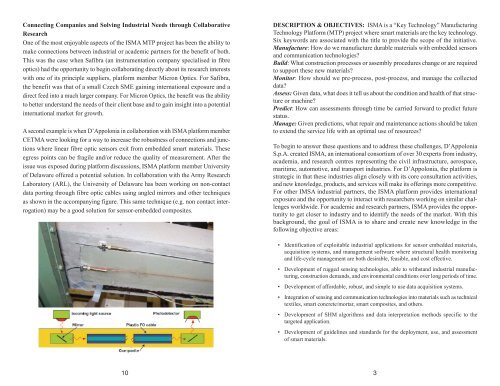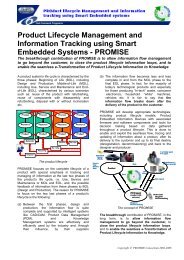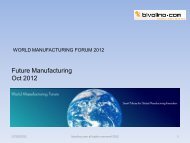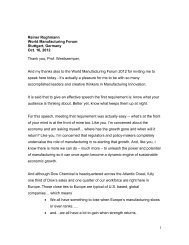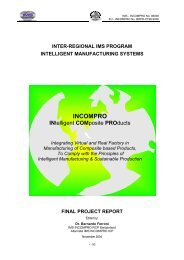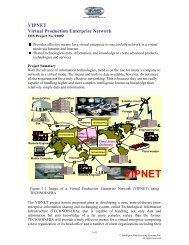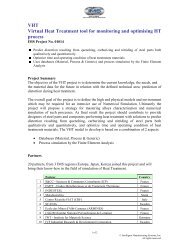ISMA Success Story - Intelligent Manufacturing Systems
ISMA Success Story - Intelligent Manufacturing Systems
ISMA Success Story - Intelligent Manufacturing Systems
You also want an ePaper? Increase the reach of your titles
YUMPU automatically turns print PDFs into web optimized ePapers that Google loves.
Connecting Companies and Solving Industrial Needs through Collaborative<br />
Research<br />
One of the most enjoyable aspects of the <strong>ISMA</strong> MTP project has been the ability to<br />
make connections between industrial or academic partners for the benefit of both.<br />
This was the case when Safibra (an instrumentation company specialised in fibre<br />
optics) had the opportunity to begin collaborating directly about its research interests<br />
with one of its principle suppliers, platform member Micron Optics. For Safibra,<br />
the benefit was that of a small Czech SME gaining international exposure and a<br />
direct feed into a much larger company. For Micron Optics, the benefit was the ability<br />
to better understand the needs of their client base and to gain insight into a potential<br />
international market for growth.<br />
A second example is when D’Appolonia in collaboration with <strong>ISMA</strong> platform member<br />
CETMA were looking for a way to increase the robustness of connections and junctions<br />
where linear fibre optic sensors exit from embedded smart materials. These<br />
egress points can be fragile and/or reduce the quality of measurement. After the<br />
issue was exposed during platform discussions, <strong>ISMA</strong> platform member University<br />
of Delaware offered a potential solution. In collaboration with the Army Research<br />
Laboratory (ARL), the University of Delaware has been working on non-contact<br />
data porting through fibre optic cables using angled mirrors and other techniques<br />
as shown in the accompanying figure. This same technique (e.g. non contact interrogation)<br />
may be a good solution for sensor-embedded composites.<br />
DESCRIPTION & OBJECTIVES: <strong>ISMA</strong> is a “Key Technology” <strong>Manufacturing</strong><br />
Technology Platform (MTP) project where smart materials are the key technology.<br />
Six keywords are associated with the title to provide the scope of the initiative.<br />
Manufacture: How do we manufacture durable materials with embedded sensors<br />
and communication technologies?<br />
Build: What construction processes or assembly procedures change or are required<br />
to support these new materials?<br />
Monitor: How should we pre-process, post-process, and manage the collected<br />
data?<br />
Assess: Given data, what does it tell us about the condition and health of that structure<br />
or machine?<br />
Predict: How can assessments through time be carried forward to predict future<br />
status.<br />
Manage: Given predictions, what repair and maintenance actions should be taken<br />
to extend the service life with an optimal use of resources?<br />
To begin to answer these questions and to address these challenges, D’Appolonia<br />
S.p.A. created <strong>ISMA</strong>, an international consortium of over 30 experts from industry,<br />
academia, and research centres representing the civil infrastructure, aerospace,<br />
maritime, automotive, and transport industries. For D’Appolonia, the platform is<br />
strategic in that these industries align closely with its core consultation activities,<br />
and new knowledge, products, and services will make its offerings more competitive.<br />
For other IMSA industrial partners, the <strong>ISMA</strong> platform provides international<br />
exposure and the opportunity to interact with researchers working on similar challenges<br />
worldwide. For academic and research partners, <strong>ISMA</strong> provides the opportunity<br />
to get closer to industry and to identify the needs of the market. With this<br />
background, the goal of <strong>ISMA</strong> is to share and create new knowledge in the<br />
following objective areas:<br />
• Identification of exploitable industrial applications for sensor embedded materials,<br />
acquisition systems, and management software where structural health monitoring<br />
and life-cycle management are both desirable, feasible, and cost effective.<br />
• Development of rugged sensing technologies, able to withstand industrial manufacturing,<br />
construction demands, and environmental conditions over long periods of time.<br />
• Development of affordable, robust, and simple to use data acquisition systems.<br />
• Integration of sensing and communication technologies into materials such as technical<br />
textiles, smart concrete/mortar, smart composites, and others.<br />
• Development of SHM algorithms and data interpretation methods specific to the<br />
targeted application.<br />
• Development of guidelines and standards for the deployment, use, and assessment<br />
of smart materials.<br />
10<br />
3


